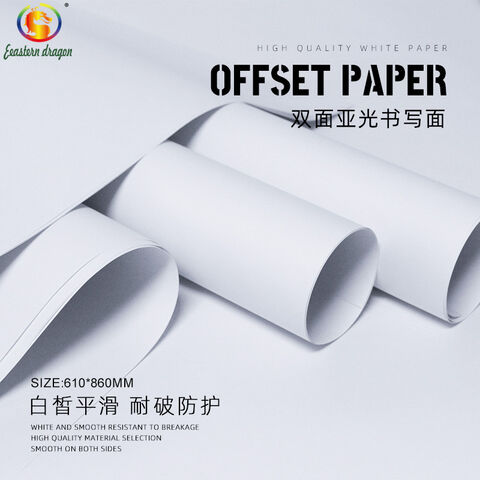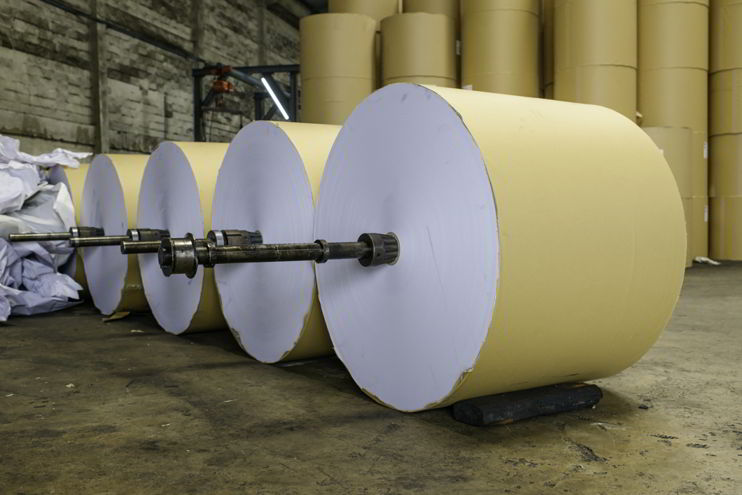Why Prioritize Sustainable Practices in Offset Paper Raw Material Sourcing?
Section 1: Understanding Offset Paper raw Material
Offset paper is widely used in the printing industry for its versatility, cost-effectiveness, and high-quality printing results. To produce offset paper, different types of raw materials are used, each with its own characteristics that impact the quality and properties of the final product.
The main types of raw materials used in offset paper production include:
- Wood Pulp: Wood pulp is the most commonly used raw material for producing high-quality offset paper. It is obtained by chemically or mechanically breaking down wood fibers. Wood pulp is known for its long fibers, which result in a stronger and more durable paper. This type of raw material produces offset paper with excellent printing and writing capabilities.
- Bamboo Pulp: Bamboo pulp is gaining popularity as a sustainable alternative to wood pulp. Bamboo is a highly renewable resource that grows rapidly and requires fewer chemicals for processing. The use of bamboo pulp in offset paper production aligns with environmental sustainability goals. The resulting paper is strong, versatile, and environmentally friendly.
- Recycled Paper: Recycled paper is another raw material option for offset paper production. It is made from discarded paper products that have been processed and transformed into pulp. Using recycled paper as a raw material helps reduce waste and conserve natural resources. The quality of recycled offset paper can vary, depending on the source and processing methods.
The choice of raw material significantly impacts the quality and characteristics of the offset paper. Wood pulp is favored for its strength and durability, while bamboo pulp offers sustainability advantages. Recycled paper provides an environmentally friendly option, although its quality may vary.
Sourcing high-quality raw materials is crucial for offset paper manufacturers for several reasons. First, using high-quality raw materials ensures the production of superior paper products that meet customer expectations. The strength, printability, and durability of offset paper rely on the quality of the raw materials used. Second, reliable sourcing of raw materials helps maintain consistent product quality and minimizes variations in paper properties. Consistency is essential in the printing industry to ensure predictable and reliable results. Finally, sustainable sourcing practices for raw materials align with increasing customer demands and industry regulations. By sourcing from reputable suppliers, offset paper manufacturers can demonstrate their commitment to environmental responsibility and sustainability.
In conclusion, understanding the different types of raw materials used in offset paper production is essential for sourcing high-quality materials. The choice of raw material impacts the quality, strength, and printability of offset paper. Offset paper manufacturers should prioritize sourcing from reliable suppliers and consider sustainable raw material options to meet customer demands and align with environmental goals.
Section 2: Best Practices in Raw Material Sourcing for Offset Paper
Effective sourcing of raw materials is crucial for offset paper manufacturers to ensure consistent product quality, meet customer demands, and optimize production processes. To achieve this, it is important to follow best practices in raw material sourcing.
- Identify Reliable Suppliers: When sourcing raw materials for offset paper production, it is essential to identify reliable suppliers. Look for suppliers who have a good track record of delivering high-quality materials consistently. Conduct thorough research, read customer reviews, and consider their certifications and industry reputation. Establishing strategic partnerships with trusted suppliers can provide long-term benefits.
- Quality Assurance: Prioritize quality assurance when sourcing raw materials. Request samples before committing to a supplier to evaluate the quality and suitability of the raw materials for your offset paper production. Perform regular quality checks and inspections to ensure consistent quality throughout the supply chain.
- Diversification: Avoid relying solely on a single supplier for raw materials. Diversify your sources to minimize the risk of supply chain disruptions and ensure a steady supply of materials. Building relationships with multiple suppliers also helps in negotiating better pricing and terms.
- Collaborate with Suppliers: Maintain open lines of communication with your suppliers. Collaborate with them to improve raw material specifications, provide feedback on quality, and discuss any issues or concerns. Regularly review and update your supply agreements to ensure both parties are aligned on quality standards and expectations.
- Sustainability: With increasing focus on sustainability, consider sourcing raw materials from suppliers who prioritize sustainable practices. Look for suppliers who promote responsible forestry or use recycled materials. Incorporating sustainable raw materials in your offset paper production can enhance your brand reputation and appeal to environmentally conscious customers.
- Risk Assessment: Assess the risks associated with raw material sourcing, including geopolitical factors, market volatility, and environmental and regulatory risks. Develop contingency plans to mitigate any potential disruptions in the supply chain. Stay informed about market trends, industry regulations, and changes that may impact raw material availability.
By following these best practices, offset paper manufacturers can ensure a reliable supply of high-quality raw materials and optimize their production processes. Sourcing from reliable suppliers and promoting sustainable practices can also position the company as a leader in the industry and strengthen its brand reputation.
Section 3: Global Trends and Innovations in Offset Paper Raw Material Sourcing
The offset paper industry is evolving, driven by global trends and innovations in raw material sourcing. Manufacturers are adopting new practices to meet the increasing demand for sustainable and eco-friendly products while optimizing their sourcing strategies.
- Global Trends: The global offset paper raw material sourcing landscape is witnessing several trends. Firstly, there is a growing emphasis on using sustainable raw materials such as recycled paper, bamboo pulp, and responsibly sourced wood pulp. This trend is driven by consumer demand for eco-friendly products and industry-wide efforts to reduce environmental impact. Secondly, there is a shift towards local sourcing to reduce supply chain risks and enhance control over the entire production process. Local sourcing also allows manufacturers to support the local economy, reduce transportation costs, and minimize carbon footprint.
- Innovation in Raw Material Sourcing: Innovation is reshaping how raw materials are sourced for offset paper production. Technological advancements, such as advanced analytics and supply chain management systems, help optimize raw material procurement. These tools enable manufacturers to monitor and analyze supply chain data, identify potential risks, and make informed decisions. Incorporating automation and digitization in the sourcing process also improves efficiency and reduces manual errors.
- Sustainable Practices: The offset paper industry is increasingly adopting sustainable practices in raw material sourcing. This includes implementing responsible forestry practices, such as reforestation and sustainable logging, to ensure a continuous supply of wood pulp. Additionally, manufacturers are exploring alternative raw materials, such as agricultural residues and straw, to reduce reliance on traditional pulp sources. By adopting sustainable sourcing practices, offset paper manufacturers contribute to environmental conservation and meet the demands of eco-conscious consumers.
In conclusion, global trends and innovations are shaping the offset paper raw material sourcing landscape. Sustainable sourcing practices and local procurement are becoming increasingly important, driven by consumer demand and environmental considerations. Technological advancements are also enabling manufacturers to optimize their raw material procurement processes. By embracing these trends and innovations, offset paper manufacturers can stay competitive, meet sustainability goals, and secure a reliable supply of high-quality raw materials.
#Tables
##Table 1: Comparison of Main Raw Materials for Offset Paper Production
| Raw Material | Characteristics | Advantages |
|---|---|---|
| Wood Pulp | Long fibers, strong and durable paper | Excellent printing and writing capabilities |
| Bamboo Pulp | Sustainable, rapid growth, requires fewer chemicals | Environmental friendly, strong and versatile |
| Recycled Paper | Made from discarded paper, reduces waste | Conserve natural resources, environmentally friendly |
##Table 2: Best Practices in Raw Material Sourcing for Offset Paper Production
| Best Practice | Description |
|---|---|
| Identify Reliable Suppliers | Research and choose suppliers with a track record of delivering high-quality materials |
| Quality Assurance | Request samples, perform regular quality checks and inspections |
| Diversification | Avoid relying on a single supplier, diversify sources to minimize supply chain risks |
| Collaborate with Suppliers | Maintain open communication, collaborate to improve specifications and address concerns |
| Sustainability | Source from suppliers with sustainable practices, promote responsible forestry and recycling |
| Risk Assessment | Assess geopolitical, market, environmental, and regulatory risks, develop contingency plans |
| FAQs about Raw Material Sourcing for Offset Paper Production |
###How does the choice of raw material impact the quality of offset paper?
To determine the impact of the raw material on offset paper quality, consider its strength and durability using the formula: Precision = tp/(tp+fp).
###What are the main types of raw materials used in offset paper production?
Identify the main types of raw materials used in offset paper production, including wood pulp, bamboo pulp, and recycled paper, to assess their properties using the formula: Recall = tp/(tp+fn).
###Why is sourcing high-quality raw materials crucial for offset paper manufacturers?
Understand the importance of sourcing high-quality raw materials to ensure consistent product quality and meet customer demands as per the quality equation: tp=number of tokens shared between the correct answer and the prediction.
###What are the best practices in raw material sourcing for offset paper production?
Follow best practices such as identifying reliable suppliers, prioritizing quality assurance, diversifying sources, collaborating with suppliers, considering sustainability, and assessing risks to optimize raw material sourcing in accordance with offset paper quality standards.
###How are global trends and innovations affecting offset paper raw material sourcing?
Explore global trends such as sustainable practices, local sourcing, and technological advancements influencing raw material sourcing for offset paper to stay competitive and meet sustainability goals for enhanced product quality.
In sum, understanding raw materials and best practices in sourcing are vital for quality offset paper. Reliable suppliers, key considerations, and sustainability drive innovation in global sourcing trends. Sustainable practices play a crucial role in offset paper manufacturing’s raw material sourcing. Offset paper production thrives on high-quality raw materials sourced sustainably.





